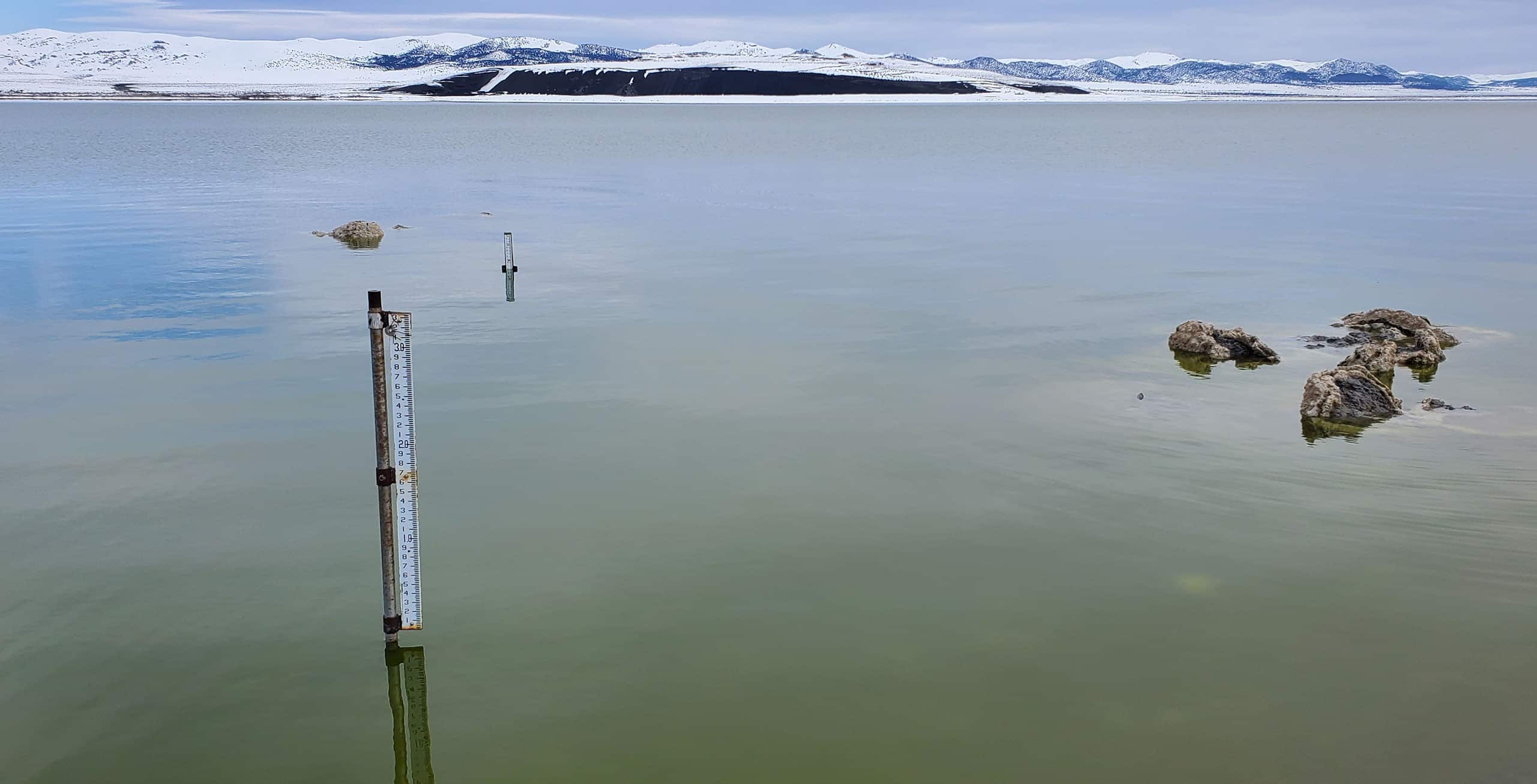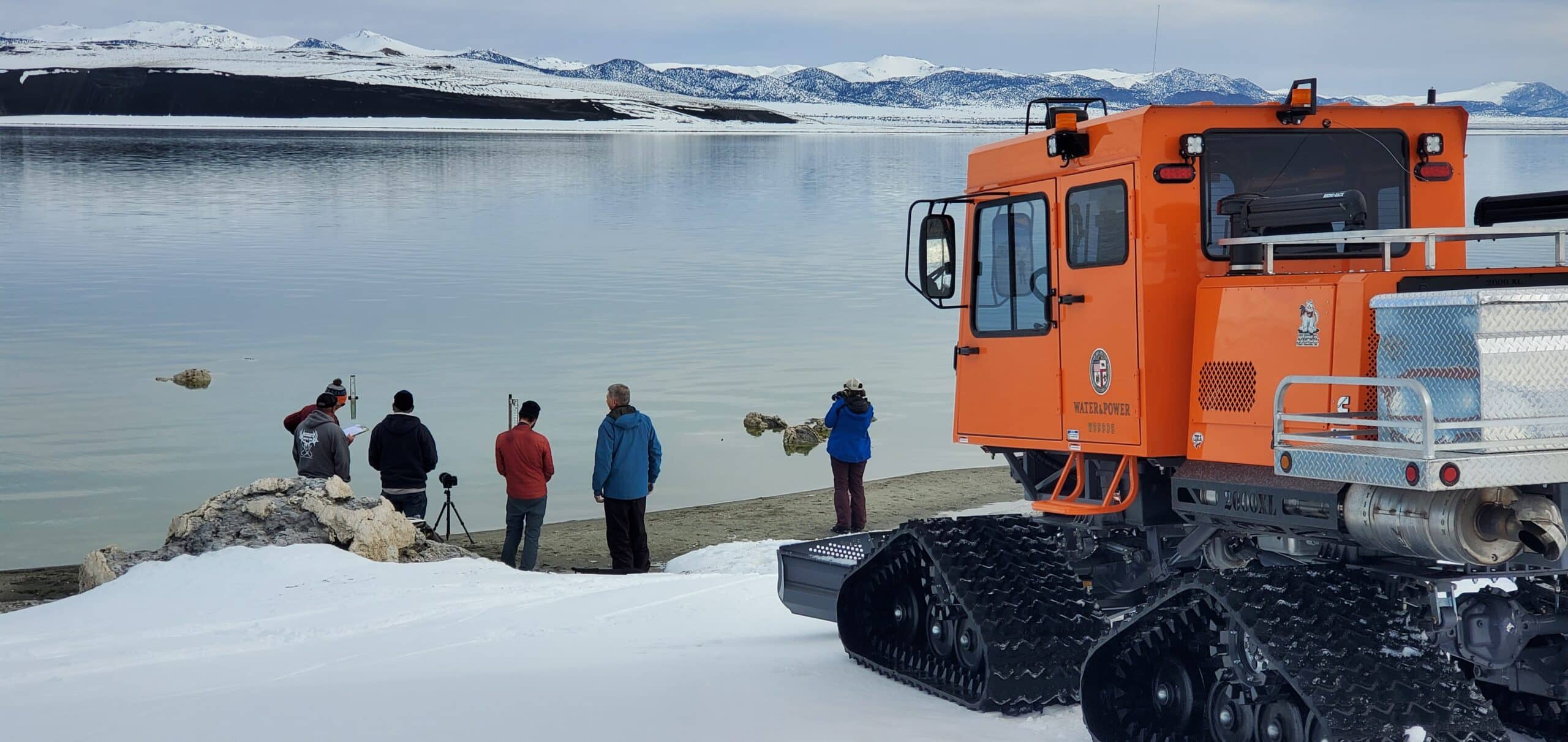
In remarkable deep snow conditions, Mono Lake Committee staff skied from Lee Vining to the lakeshore this morning, April 1, to read the level of Mono Lake cooperatively with the Los Angeles Department of Water & Power (DWP). The level today establishes the maximum allowed DWP water exports for the next twelve months, and this year was an unprecedented photo finish at a critical threshold.
Narrow margin of decision
The official consensus reading was 6379.99 feet above sea level, a mere eighth of an inch—the thickness of two quarters and less than the length of a Mono Lake brine shrimp—below the 6380.00 threshold set forth in DWP’s licenses to divert water from Mono Lake’s tributary streams.

The level means that DWP can proceed to export 4,500 acre-feet of water in the runoff year ahead, although there is little need for it in this wet year and the Committee has asked that diversions be temporarily suspended until the lake rises to the higher, healthy level mandated by the State Water Board.
Big gains for Mono Lake
Had the lake been 0.01 feet higher, which a few warm snowmelt days could have made happen, that allocation would have nearly quadrupled to 16,000 acre-feet, holding back the lake’s rise by a third of a foot. With the lake a decade late and only 30% of the way to the required protection level of 6392 feet, this illustrates how DWP diversions are mismatched with the lake’s recovery. It has been almost 30 years since the State Water Board modified DWP’s water exports with the express purpose of protecting Mono Lake’s unique habitats and complying with clean air health standards by raising Mono Lake to a level 12 feet higher than today’s reading.
The lake level reading is good news for Mono Lake this year as almost all of the extremely wet winter’s snowfall will melt and flow into the lake in the months ahead. Committee hydrology analysis is ongoing; currently we expect the lake to rise three or more feet from today’s level due to high levels of runoff expected between now and September.
It’s good news for DWP too, which is already racing to deal with more Sierra runoff than the aqueduct can handle, generating a recent declaration of a state of emergency by the Mayor of Los Angeles.


Reprieve for California Gulls
The outlook is also temporary good news for nesting California Gulls, which were under severe threat of predators crossing the landbridge to the nesting islands just a few months ago. The remarkable recent rise in the lake has provided welcome quick relief from the threat and affected plans for a temporary protection fence in 2023. But a single wet year is not a management plan, and it is essential to preserve the gains of this wet year. The significant rise in lake level after the wet 2017 year was lost in subsequent drier years as DWP continued to divert the maximum allowed.
Last December the dire low lake situation caused the Committee to ask the State Water Board to take action. As a result, the State Water Board scheduled a workshop in February and heard a strong case for the need to hold a hearing and put the lake’s recovery to the D1631 requirement back on track. Updates from the Board on next steps are anticipated in April.
Be it birds, people, brine shrimp, clean air, or Tribal cultural values—ensuring Mono Lake quickly rises to the mandated higher, healthier lake level matters for the future of the lake and for future generations of Californians.”
–Geoff McQuilkin, Mono Lake Committee Executive Director
The diversion maximum will not affect DWP’s export of groundwater from the Mono Basin in the Mono Craters Tunnel, which will continue unchanged and separately provides more than 5,000 acre-feet of water to Los Angeles.
The morning was momentous at the lakeshore, and as we strapped on our skis to return home we were reminded of the urgency of protecting Mono Lake by California Gulls calling distinctively from high overhead as they winged their way toward nesting sites on the islands. Be it birds, people, brine shrimp, clean air, or Tribal cultural values—ensuring Mono Lake quickly rises to the mandated higher, healthier lake level matters for the future of the lake and for future generations of Californians.
